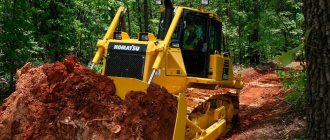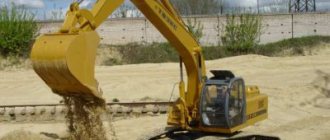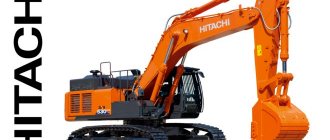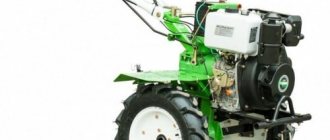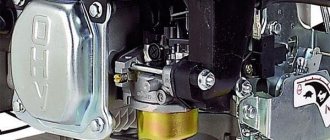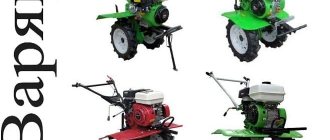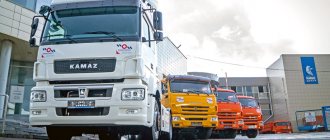Hard-working and easy-going
For a variety of reasons, hydraulic crawler excavators in the 25-35t weight class occupy an important place in the market. This "versatile workhorse" segment is one of the largest and fastest growing crawler excavator segments in the global market.
Note that it is quite difficult to select excavator models that are exactly within the considered range of operating weights, since each model has a number of configurations of different weights. For example, mod. The Volvo EC300EL in its lightest configuration weighs 29,360 kg, and after installing wide tracks, a large counterweight and reinforced boom and arm, the weight increases to 31,630 kg (2,270 kg).
High productivity and ease of transportation - a successful combination
One of the main advantages of hydraulic excavators weighing from 25 to 35 tons is that, due to their fairly large size and weight, they are capable of performing large volumes of earthmoving work and at the same time are relatively compact and can be easily transported from one construction site to another. Of course, they are inferior to heavier machines designed for large-scale excavation, but they develop sufficient excavation performance to be successfully used on large construction projects. Their fairly high power with small size is of great importance for working in cramped construction conditions.
These versatile machines can be used on a wide range of construction sites and are used to perform a variety of jobs across many industries - from large infrastructure projects to underground utility installations, from road construction to pipeline installations, from greenfield site preparation to demolition. and structures.
Thus, Volvo CE offers E series models - EC250E and EC300E with engines with a power of 159 and 179 kW, respectively. The operating weight of these machines, depending on the configuration, is 25.5–28.93 tons for the EC250E and 29.22–32.77 tons for the EC300E. The chassis of the excavators is reinforced. The strong lower X-shaped frame ensures even load distribution. In terms of functionality, they can be called universal-purpose machines, since they occupy an intermediate position between a machine that carries replaceable attachments and a machine for large volumes of earthmoving work.
Domestic - a joint venture of the Russian Machines corporation and Terex Corporation - offers mods in the weight range under consideration. ET-26 weighing 26.5 tons with a 132 kW engine. A powerful, unpretentious earthmoving machine is designed for developing soils of categories I–IV, loosened rocks and frozen soils, and loading and unloading bulk materials.
The upper part of this weight range includes Case : mod. СХ350В weighing 34.2 kW and mod. CX370B weighing 36.2 tons. Both machines are equipped with a 202 kW engine. The manufacturer offers several options for handles with lengths from 2.21 to 4.04 m.
There are also highly specialized models in this weight range, for example, Liebherr offers a mod tunneling excavator. R924 Compact with a 129 kW engine and a weight of 33–34.5 tons. The machine is equipped with a special handle and boom “for work in tunnels” with a mechanism that tilts the working tools by 2x45° and with a quick-release adapter for connecting interchangeable attachments. The hydraulic equipment on the boom is optimized for connecting the milling drill head.
The offer from Hidromek is a powerful, reliable and comfortable HMK300LC excavator with a bucket volume of 1.5 m3 and a weight of 31 tons, which is equipped with a 151 kW engine of Tier 3 emission class or a 161 kW engine of Tier 2 class. Reinforced frame design and working equipment for rocky soils, combined with a reliable and economical engine, allows this machine to be used for excavation work and for loading and unloading inert materials. Additional configurations with a narrow lower frame or extended working equipment will allow you to select the machine that best meets the needs of customers.
Price
The Volvo 700 is a rather expensive vehicle. The cost of a new excavator starts from 27 million rubles and up to 32 million Russian rubles, taking into account the year of production and configuration.
Machines with operating time have a cost ranging from 17 million rubles to 23 million Russian rubles, depending on the year of production and general technical condition.
You can also rent a car for an hour at a price of 5,000 rubles. The cost of transporting equipment to the site requires an additional fee.
Design Features
“Narrow” chassis. Many models in the 25-35t range have versions with a "narrow" or "narrow long" undercarriage, which is the same width as standard but longer than standard. This chassis increases the value of the tipping load and makes the excavator more stable when digging with the boom in the longitudinal plane. For example JCB mod. The JS240SC with a 140 kW engine and a weight of 24.5 tons is also available with a “narrow and long” chassis – mod. JS240NLC weighing 25.06 tons.
Additional hydraulic circuits. To increase versatility and profitability, the machines can be equipped with additional hydraulic circuits with different flow and pressure values for connecting attachments - a hydraulic hammer, hydraulic shears, rotator, etc.
For example, the Hidromek excavator from the GEN series mod. HMK300LC is already equipped as standard with an additional hydraulic line for the hydraulic hammer; the line for the hydraulic rotator is installed at the request of the customer.
New Holland excavators mod. E305B with an engine power of 152 kW and a weight of 31.62 tons, the proprietary HAOA hydraulic system with load-dependent performance control includes additional hydraulic lines for connecting a hydraulic hammer and hydraulic shears.
Low rear reach. Excavator models with reduced or zero rear reach are typically in the lighter weight classes, but builders often need excavators that can work in tight spaces while still having the lifting capacity to lift large structures, large diameter pipes, and metal trenches. formwork. Therefore, models with a reduced rear reach have now begun to appear among heavier vehicles.
For example, from the technical characteristics of the mod. Kobelco SK260SRLC-3 shows that this 26.9 ton vehicle has a rear overhang of 190 mm from the vertical, passing through the outermost point of the tracks.
Caterpillar recently released two relatively heavy machines with reduced rear reach: the mod. 325F L weighing about 27 tons and mod. The 335L CR weighs just over 36,300kg. Equipped with 800mm wide track shoes, these models have rear overhangs of 140mm and 190mm respectively.
Maud. The Volvo ECR305, weighing up to 37.34 tonnes, and the ECR235EL, weighing 27.3 tonnes, in their heaviest configuration, have a rear overhang of 89 and 203 mm respectively, with a track shoe width of 800 mm.
Extra long working equipment. Some models in the 25-35t class are offered in “long front” or “super long front” configurations, otherwise known as “extended reach equipment”. A machine with extra-long working equipment can have a reach of 6–9 m greater than that of a standard model, but remains no less stable due to the strengthening of the chassis and heavier counterweight. Typically, such machines are used for the construction and repair of port facilities and industrial settling ponds.
Just because a machine is equipped with extra-long attachments does not mean it is only designed for long reach and light load applications. Some excavator owners purchase two sets of working equipment for their machines: standard and extra-long and use excavators for various jobs where such equipment is used, including work with heavy loads that can be carried out with a standard boom. Extra-long attachment kits for installation on standard excavator models of a certain weight are usually sold only by companies that supply parts to the aftermarket.
As an example, we can cite the Komatsu Super Long Front PC290LC-10 and PC360LC-10 models, whose horizontal reach above the ground reaches almost 18 m. Thanks to their features, these machines are readily rented.
At mod. Doosan DX300LC-5 with extra-long working equipment compared to the standard modification, the horizontal reach increased from 10.516 to 19.836 m; digging depth – from 7.29 to 13.767 m; and the unloading height – from 7.264 to 11.963 m.
Hidromek has in its line a modification of the HMK300LCLR excavator with an extra-long arm (7.8 m) and boom (10.3 m), resulting in a maximum digging radius at parking level of 18.2 m.
Most manufacturers offering machines with “extended reach equipment” emphasize that excavators with extra-long attachments should not be confused with dedicated demolition models, which can also be equipped with an extra-long boom, but not always.
For example, Hitachi offers the Zaxis 240LC-5G (132 kW engine, weight 28–28.3 tons) with extra-long implements. A 7.51 m long arm can be fitted in combination with a 10.21 m boom, providing a digging radius of up to 18.29 m at parking level. The second option is an 8.28 m long handle together with an 11.32 m boom: in this case, soil development can be carried out at a distance of up to 20 m.
Specifications
Bucket characteristics:
- The smallest capacity of the installed bucket is 2.48 cubic meters.
- The largest capacity of the installed bucket is 6.6 cubic meters.
- The greatest breakout force of the bucket is 374 kilonewtons.
Engine characteristics:
- The type of engine installed is in-line, diesel.
- Engine make: D16E EAE3.
- Engine manufacturer – Volvo.
- Number of cylinders – 6.
- The working volume of all cylinders is 16100 cubic meters.
- Rated output power is 346 kilowatts/470 horsepower (at 1800 rpm).
- The nominal crankshaft rotation speed is 1800 rpm.
- Maximum torque – 2250 newtons per meter (at 1450 rpm).
- The diameter of the cylinders is 144 millimeters.
- Type of cooling system – liquid.
- Starting system type: electric starter.
- The type of turbocharging system is gas turbine with subsequent cooling of the charge air.
- The lowest fuel consumption per working hour is 27.9 liters.
- The highest fuel consumption per working hour is 33.5 liters.
- The highest speed of independent movement is 3.1 kilometers per hour.
Dimensions:
- The structural length of the excavator is 13200 millimeters.
- The width of the tracked platform is 4286 millimeters.
- The total height of the cabin is 4950 millimeters.
- Ground clearance - 858 millimeters.
- Track (longitudinal) base – 4750 millimeters.
- The width of the tracks is 650 millimeters.
- The track width of the tracked platform is 3350 millimeters.
- The smallest turning radius of the rear part of the platform is 4090 millimeters.
Automated leveling control systems and telematics
Automated systems for controlling the leveling process have been developed for hydraulic excavators, but they have not yet reached the level of automation and such widespread distribution as similar systems for bulldozers and motor graders. Experts say one of the main problems is the difficulty in determining the location of underground infrastructure communications, which an excavator can damage during “unmanned” work. But work to improve control systems continues.
Telematics is also playing an increasingly important role in improving the overall efficiency of an excavator, allowing for remote diagnostics of a running machine, timely delivery of necessary parts and maintenance. According to a survey conducted by an industry magazine, 25% of respondents who own excavators said they use automated leveling control systems on their machines.
For example, the Doosan company offers a mod. DX255LC-5 weighing 25.4–26.5 tons with a 137 kW engine, which is equipped with the company’s CoreTMS telematics fleet management system. The system transmits, receives and archives detailed data on the operation of the machine using telematics equipment via satellite communications or GSM, provides the ability to remotely control equipment from the company’s central office, can generate reports for certain periods of time and perform machine diagnostics.
Hitachi equips its excavators, such as the mod. ZX280-5G (engine 132 kW, weight 27.4–28.4 t) and mod. ZX330-5G (engine 184 kW, weight 31.5–34.1 tons) telematic interactive fleet management system Global e-Service, which allows remote access to technical and operational information on any machine in the fleet using a personal computer installed in office of the owner company.
Komatsu recently developed the iMC (intelligent Machine Control) system for its excavator mod. PC210LCi-11, and according to a statement from company representatives, this technology will be used on larger machines.
The iMC system uses a set of sensors that detect the movements of hydraulic cylinder rods, inertial acceleration sensors and antennas for receiving GPS/GLONASS satellite signals. The system determines the position of the bucket edge, checks it against a 3D digital model of the construction project loaded into the electronic control unit, and if the bucket moves beyond the boundaries specified in the design, the system semi-automatically limits its movement to prevent the excavation of excess soil. If the operator disables the automatic mode, the system will only operate in indication (guidance or warning) mode.
Selecting an excavator weighing 25–35 tons
Research by marketers has shown that the first place in importance among the factors influencing the decision to purchase an excavator weighing from 25 to 35 tons is the brand of equipment and the organization of after-sales service by the dealer (reputation of the dealer), and in second place, with a minimal gap, is price. As a rule, consumers pay attention first of all to the performance of cars in this class, and then to fuel efficiency and versatility. Often, construction companies prefer heavier machines from the upper part of the specified weight range, because they have greater reach and lifting capacity, and there is no significant difference in size with excavators from the lower part of the range.
Nearly 60% of excavator owners surveyed said they base their excavator performance on the lifting capacity of the truck body that will work with the excavator and the number of excavator cycles required to load the truck.
Compared to 2010, the global market for excavators weighing 25–35 tons has now strengthened and more than doubled. The latest generations of machines have higher performance and a more robust and reliable design.
One of the main categories of buyers of machines of this class are rental companies, and their clientele are builders who work on sites located far from each other and prefer to rent an excavator somewhere nearby, rather than purchasing it and carrying it with them. object to object, spending considerable money on transportation.
